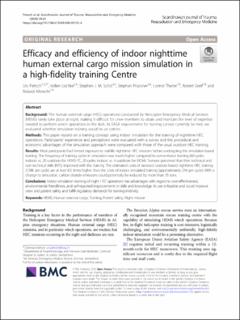| dc.contributor.author | Pietsch, Urs | |
| dc.contributor.author | Lischke, Volker | |
| dc.contributor.author | Sollid, Stephen J. M. | |
| dc.contributor.author | Prückner, Stephan | |
| dc.contributor.author | Theiler, Lorenz | |
| dc.contributor.author | Greif, Robert | |
| dc.contributor.author | Albrecht, Roland | |
| dc.date.accessioned | 2021-03-15T12:34:29Z | |
| dc.date.available | 2021-03-15T12:34:29Z | |
| dc.date.created | 2020-11-12T14:46:32Z | |
| dc.date.issued | 2020-06 | |
| dc.identifier.citation | Pietsch, U., Lischke, V., Sollid, S.J.M. et al. (2020) Efficacy and efficiency of indoor nighttime human external cargo mission simulation in a high-fidelity training centre. Scandinavian Journal of Trauma, Resuscitation and Emergency Medicine, 28 . | en_US |
| dc.identifier.issn | 1757-7241 | |
| dc.identifier.uri | https://hdl.handle.net/11250/2733415 | |
| dc.description.abstract | Background
The human external cargo (HEC) operations conducted by Helicopter Emergency Medical Services (HEMS) rarely take place at night, making it difficult for crew members to attain and maintain the level of expertise needed to perform winch operations in the dark. As EASA requirements for training cannot currently be met, we evaluated whether simulation training could be an option.
Methods
This paper reports on a training concept using indoor simulation for the training of nighttime HEC operations. Participants’ experience and perceptions were evaluated with a survey and the procedural and economic advantages of the simulation approach were compared with those of the usual outdoor HEC training.
Results
Most participants had limited exposure to real-life nighttime HEC missions before undergoing the simulation-based training. The frequency of training cycles in simulation was much higher compared to conventional training (60 cycles indoors vs. 20 outdoors for HEMS-TC, 20 cycles indoors vs. 4 outdoors for MCM). Trainees perceived that their technical and non-technical skills (NTS) improved with the training. The estimated costs of standard outdoor-based nighttime HEC training (138€ per cycle) are at least 6.5 times higher than the costs of indoor simulated training (approximately 21€ per cycle). With a change to simulation, carbon dioxide emissions could potentially be reduced by more than 35 tons.
Conclusions
Indoor simulation training of night HEC operations has advantages with regard to cost-effectiveness, environmental friendliness, and self-reported improvements in skills and knowledge. Its use is feasible and could improve crew and patient safety and fulfill regulatory demands for training intensity. | en_US |
| dc.language.iso | eng | en_US |
| dc.publisher | BioMed Central | en_US |
| dc.rights | Navngivelse 4.0 Internasjonal | * |
| dc.rights.uri | http://creativecommons.org/licenses/by/4.0/deed.no | * |
| dc.subject | luftambulanse | en_US |
| dc.subject | trening | en_US |
| dc.subject | opplæring | en_US |
| dc.subject | simuleringsbasert trening | en_US |
| dc.title | Efficacy and efficiency of indoor nighttime human external cargo mission simulation in a high-fidelity training centre | en_US |
| dc.type | Peer reviewed | en_US |
| dc.type | Journal article | en_US |
| dc.description.version | publishedVersion | en_US |
| dc.rights.holder | © The Author(s). 2020 | en_US |
| dc.subject.nsi | VDP::Medisinske Fag: 700::Klinisk medisinske fag: 750::Traumatologi: 783 | en_US |
| dc.source.pagenumber | 7 | en_US |
| dc.source.volume | 28 | en_US |
| dc.source.journal | Scandinavian Journal of Trauma, Resuscitation and Emergency Medicine | en_US |
| dc.identifier.doi | 10.1186/s13049-020-00755-4 | |
| dc.identifier.cristin | 1847442 | |
| dc.source.articlenumber | 61 | en_US |
| cristin.ispublished | true | |
| cristin.fulltext | original | |
| cristin.qualitycode | 1 | |

